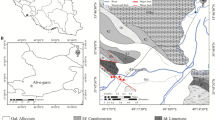Abstract
The Mahallat hot springs are located in the city of Mahallat, central Iran. This region is famous for its balneotherapy and health tourism attractions. They are located in the transitional zone between the Sanandaj–Sirjan (mainly metamorphosed zone) and the Orumieh–Dokhtar (mainly volcanic zone) structural zones. The host rocks of the region include sedimentary to volcanic rocks (Permian to Quaternary), but Quaternary-aged alluvium and travertine layers are the main outcrops. Additionally, these features reveal that thermal and shallow ground waters had been mixed before hot springs exposure. The chemistry data show that these waters are enriched in Ca2+, Mg2+, Na+, Cl−, HCO3−, and SO42− as well as U and NO3−. The chemistry of thermal and shallow groundwater samples are graphed in the Cl−–SO42−–HCO3− ternary and other diagrams. In addition, hot springs having high NO3−-concentrations indicate that thermal waters mix with shallow groundwater, which are attributed to agricultural and other anthropogenic activities. The hot springs have high U concentration that may result in shallow groundwater mixing with andesitic tuff, granodiorite, shale, and schist of the region. Therefore, the local farms and agricultural crops as well as local residents’ health could be at risk of exposure to the U and NO3− pollution.





Similar content being viewed by others
References
Aghanabati A (2004) Geology of Iran. GSI Publication, Tehran
American Public Health Association (APHA) (1992) Standard method for the examination of water and wastewater. APHA, Washington, DC
Esmaeili-Vardanjani M, Shamsipour-Dehkordi R, Eslami A, Moosaei F, Pazand K (2013) A study of differentiation pattern and rare earth elements migration in geochemical and hydrogeochemical environments of Airekan and Cheshmeh Shotori regions (Central Iran). Environ Earth Sci 68:719–732
Esmaeili-Vardanjani M, Rasa I, Yazdi M, Pazand K (2016) The hydrochemical assessment of groundwater resources in the Kadkan basin, Northeast of Iran. Carbonates Evaporites 31(2):129–138. https://doi.org/10.1007/s13146-015-0248-3
Gansser A (1971) The Taftan volcano (SE Iran). Eclogae Geol Helv 64:319–334
Giggenbach WF (1988) Geothermal solute equilibria. Derivation of Na–K–Ca–Mg geoindicators. Geochim Cosmochim Acta 52:2749–2765
Iran Water Resources Managaement Co. (IWRM) online database. Accessed: September 2018. http://www.wrm.ir/#Info
Marini L (2000) Geochemical techniques for the exploration and exploitation of geothermal energy, Universita` degli Studi di Genova. Dipartimento per lo Studio del Territorio e delle sue Risorse, Genova
Mehdizadeh H, Liotard JM, Dautria JM (2002) Geochemical characteristics of an intracontinental shoshonitic association: the example of the Damavand volcano, Iran. C R Geosci 334:111–117
Milvy P, Cothern CR (1990) Scientific background for the development of regulations for radionuclides in drinking water. In: Cothern CR, Rebers P (eds) Radon, radium and uranium in drinking water. Lewis Publishes, Chelsea, pp 1–16
Pentecost A, Jones B, Renaut RW (2003) What is a hot spring? Can J Earth Sci 40:1443–1446
Saadat S, Charles RS (2011) Petrochemistry and genesis of olivine basalts from small monogenetic parasitic cones of Bazman stratovolcano, Makran arc, southeastern Iran. Lithos 125:607–619
Shakeri A, Moore F, Kompani-zare M (2008) Geochemistry of the thermal springs of Mount Taftan, southeastern Iran. J Volcanol Geotherm Res 178:829–836
Shakeri A, Ghoreyshinia S, Mehrabi B, Delavari M (2015) Rare earth elements geochemistry in springs from Taftan geothermal region SE Iran. J Volcanol Geoth Res 304:49–61. https://doi.org/10.1016/j.jvolgeores.2015.07.023
Sheikholeslami MR (2005). Mahallat Quadrangle Map 1:100,000. Geological Survey of Iran
USEPA United States Environmental Protection Agency (2009) National primary drinking water regulations. [Online] 2009. http://www.epa.gov/safewater/contaminants/index.html. Accessed 20 Apr 2019
Yazdi M, Taheri M, Navi P (2014) Environmental geochemistry and sources of natural arsenic in the Kharaqan hot springs, Qazvin, Iran. Environ Earth Sci 73(9):5395–5404. https://doi.org/10.1007/s12665-014-3794-4
Yazdi M, Navi P, Tahmasi O (2016) Hydrogeochemical characteristics of Mahallat hot springs, central Iran. J Tethys 4(2):169–179
Author information
Authors and Affiliations
Corresponding author
Additional information
Publisher's Note
Springer Nature remains neutral with regard to jurisdictional claims in published maps and institutional affiliations.
Rights and permissions
About this article
Cite this article
Nikpeyman, Y., Yazdi, M., Tahmasi, O. et al. The hydrogeochemical assessment of hot springs in Mahallat region, central Iran. Environ Earth Sci 78, 597 (2019). https://doi.org/10.1007/s12665-019-8612-6
Received:
Accepted:
Published:
DOI: https://doi.org/10.1007/s12665-019-8612-6




